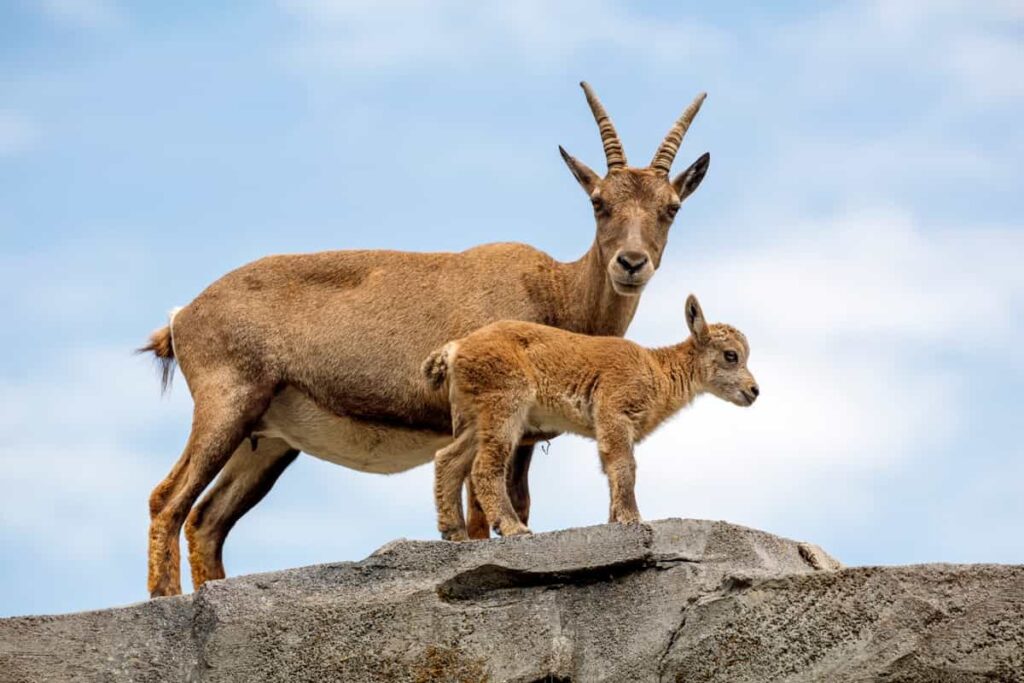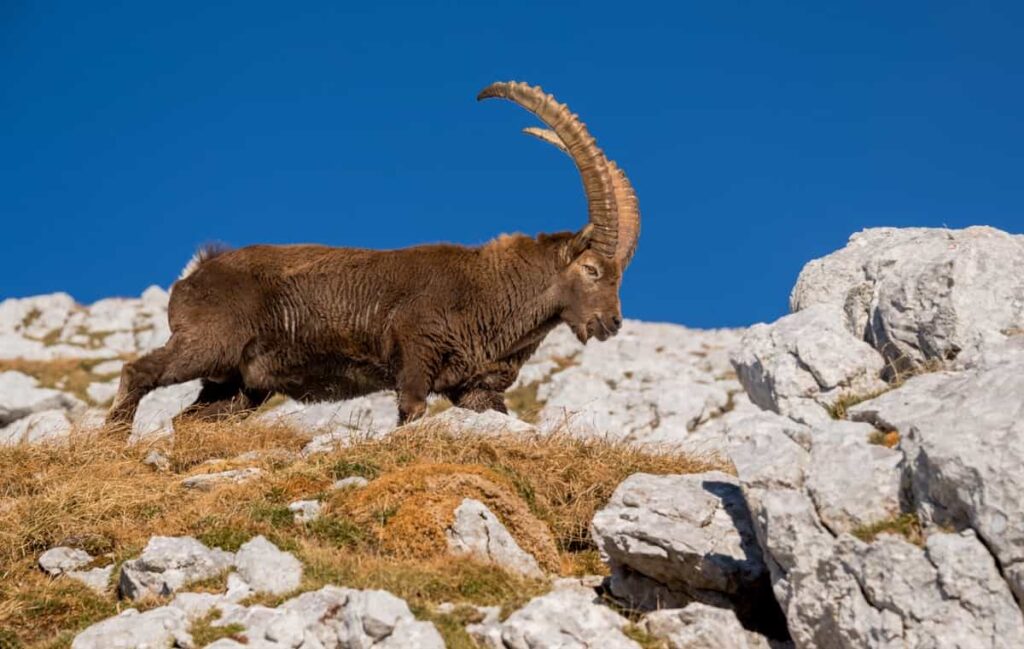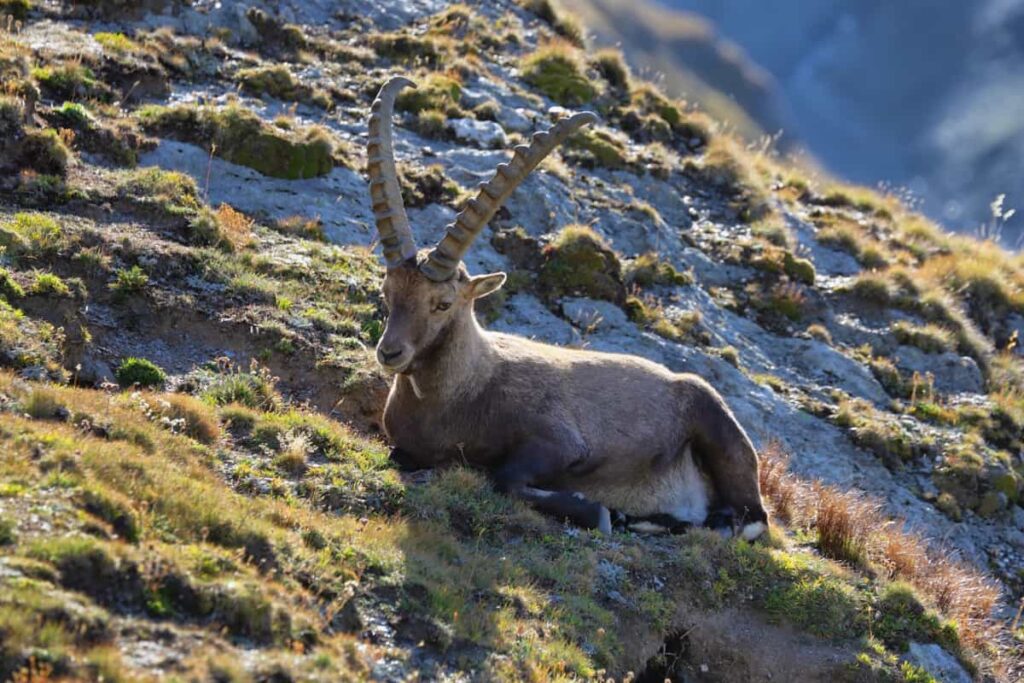The benefit of raising Ibex Wild Goats is their ability to adapt to rugged terrains and harsh climates. Their strong hooves allow them to navigate steep slopes, contributing to soil erosion control easily. By grazing on various plant species, they help regulate vegetation growth, preventing the dominance of invasive plants that could harm other wildlife.

Ibex Wild Goat Profile
Physical Characteristics and Adaptations of the Ibex Wild Goat
The Ibex wild goat is a remarkable creature, perfectly adapted to its rugged mountainous habitat. With their distinctive cloven hoofs and impressive set of long horns curving over their back, these goats are a sight to behold. Adult males tip the scales around 100 kg (220 pounds), while females are slightly smaller at about 50 kg (110 pounds). Their sturdy build allows them to navigate steep slopes with ease and agility.
One of the most striking features of the Ibex wild goat is undoubtedly their magnificent horns. These curved beauties serve multiple purposes, from defending against predators to establishing dominance within their herd. Living in herds certainly has advantages for social behavior and communication among ibex goats. This helps protect individuals from predators and assists with finding food sources more efficiently through collective efforts.
Habitat and Distribution of the Ibex Wild Goat: From Mountains to Deserts
The Ibex wild goat is a truly adaptable creature, capable of surviving in diverse habitats ranging from mountain peaks to arid desert plains. Their ability to thrive amidst such contrasting landscapes is a testament to their remarkable resilience. The Nubian Ibex takes residence in the deserts of northeastern Africa, where temperatures soar and water sources are scarce.
It has adapted by developing elongated hoofs that help it maneuver through shifting sands while conserving energy. These incredible goats have conquered them all, from snow-covered peaks to scorching hot deserts. Their distribution spans continents, showcasing their adaptability and survival skills in various ecosystems.
Diet and Feeding Habits of the Ibex Wild Goat: A Versatile Herbivore
The Ibex wild goat is a true connoisseur when it comes to food. With its versatile palate, this herbivorous creature can adapt to various landscapes and find sustenance in even the harshest environments. Feeding primarily on grasses, leaves, shrubs, and herbs, the Ibex has mastered the art of foraging.
In case you missed it: How Much Space Do You Need for 100 Goats: Estimate for 200, 300, 400, 500, and 1000 Goats

Its strong jaw muscles and sharp incisors help it graze efficiently, allowing it to consume various plants easily. Their ability to balance precariously on rocky ledges makes them masters of their terrain. In addition to being skilled climbers and nimble grazers, these wild goats also have a unique way of obtaining essential salts from natural mineral deposits found in their environment.
They supplement their diet with vital nutrients by licking rocks or consuming soil rich in minerals like calcium or sodium chloride (salt). As adaptable herbivores who thrive on varied diets depending on location and availability of resources, Ibex demonstrates incredible resilience as survivors in diverse ecosystems worldwide.
Reproduction and Life Cycle of the Ibex Wild Goat: Strategies for Survival
The reproductive cycle of the Ibex Wild Goat is an intriguing process that allows these creatures to ensure their survival in challenging environments. During mating season, typically in late fall or early winter, adult males engage in fierce battles to create dominance and win the right to mate with females. After mating, female Ibex goats experience a gestation period of around 5-6 months before giving birth to a single kid.
To protect their young from predators such as wolves or eagles, ibex mothers lead them into cliffs or inaccessible areas where they can find safety. As the kids grow older, they become independent but remain close to their mother’s side for guidance and protection until they reach maturity. The life cycle of an Ibex goat is marked by its resilience and adaptability.
Social Behavior and Communication in Ibex Wild Goats: Living in Herds
Ibex wild goats are highly social animals, typically in herds of males and females. These herds range from just a few individuals to larger groups of a dozen goats. Living together in a herd provides numerous benefits for the Ibex, including increased protection against predators and improved access to food sources. Understanding their social behavior sheds light on their intricate communication systems and underscores the importance of protecting their natural habitats.
In case you missed it: Goat Farming in Zimbabwe: A Step-by-step Guide for Beginners

Predators and Threats to the Ibex Wild Goat Population: Balancing Survival
Smaller carnivores like foxes and golden eagles can exploit weak or young ibex individuals. These opportunistic hunters are always on the lookout for an easy meal. Human activities also play a significant role in threatening the survival of these magnificent creatures. Habitat loss due to deforestation and urbanization has greatly impacted their numbers. Illegal hunting for their valuable horns and meat further exacerbates their decline.
Climate change is yet another challenge that affects the ibex population. Rising temperatures have led to changes in vegetation patterns, reducing food availability for these herbivores. Balancing survival becomes crucial when considering all these threats facing ibex populations worldwide. Conservation efforts must focus on protecting both natural habitats and enforcing strict regulations against poaching.
Conservation Efforts for the Ibex Wild Goat: Protecting an Iconic Species
The key strategy employed in conserving the Ibex wild goat population is establishing protected areas where they can thrive undisturbed. By safeguarding their habitats and creating safe havens, these goats have a fighting chance at survival. Additionally, various research projects aim to understand their behavior and ecology better. This knowledge helps inform conservation plans and allows experts to identify potential threats before they cause irreversible damage.
Collaboration between local communities, governments, and environmental organizations has proven crucial in successful conservation efforts. Through education initiatives and raising awareness about the importance of protecting this species, people are becoming more invested in preserving these magnificent creatures for future generations. Innovative approaches such as community-based tourism programs provide economic incentives for locals while simultaneously promoting wildlife protection.
Create a sense of ownership over these natural treasures by involving communities living near Ibex habitats in sustainable practices like ecotourism. Furthermore, strict regulations on hunting have been put into place across many regions where Ibex populations exist. Limited permits and controlled harvests help maintain viable population sizes while respecting traditional cultural practices.
In case you missed it: How to Select Goats for Milk or Meat: A Simple Guide with Best Tips and Techniques

Raising Ibex Wild Goat Table
| Goat Characteristics | Raising Habits |
| Size | Varies based on subspecies, but generally stands 80–100 cm high at the shoulder |
| Weight | Adult males – 100 kg, Females – 50 kg |
| Coat | Thick and coarse, providing insulation against harsh weather conditions |
| Horns | Impressive curved horns in both males and females, used for defense and territorial displays |
| Habitat | Thrives in rugged mountainous regions with rocky terrain |
| Distribution | Found across various continents, including Europe, Asia, Africa, and North America |
| Diet | Primarily herbivorous, feeding on grasses, leaves, shrubs, mosses |
| Breeding Season | Typically, the season occurs during late fall or early winter |
| Predators And Threats | Natural predators include wolves, lynx, bears, golden eagles, and humans who hunt for their meat, hides, and horns |
Conclusion
The benefit of raising Ibex Wild Goats is their adaptability to various environments. In addition to their ecological impact, raising Ibex Wild Goats also holds cultural significance. Humans have revered these majestic creatures for their beauty and resilience throughout history. They feature prominently in folklore and art forms across many regions where they are found.
- Types of Grass Growing for Goat Farm
- How to Train Goats for Milking: A Beginners Guide
- Goat Milking Practices and Equipment: A Beginner’s Guide
- Goat Farming for Fiber: Producing Mohair and Cashmere
- Maximizing Goat Milk Production: Tips for Dairy Goat Farmers
- Goat Farming as a Family Business: Strategies for Success
- Profitable Kenya Goat Breeds for Commercial Dairy and Meat Business
- Unlock the Secrets of Oberhasli Goat: Discover Raising and Management Practices
- Ultimate Guide to Myotonic Goats: Explore Profile to Raising